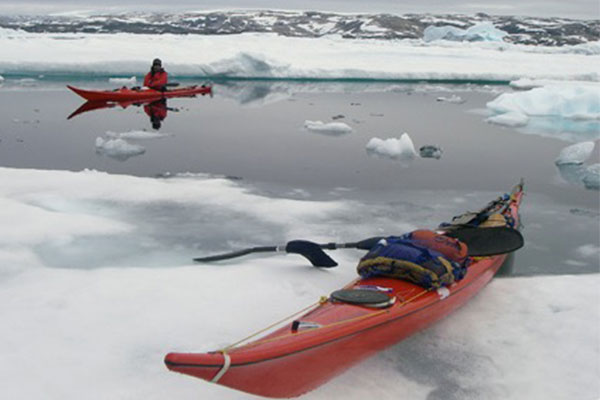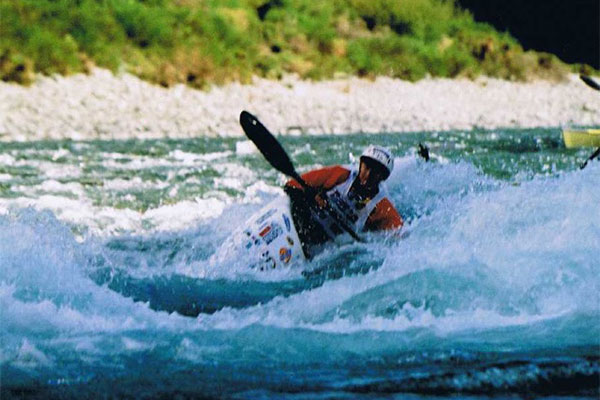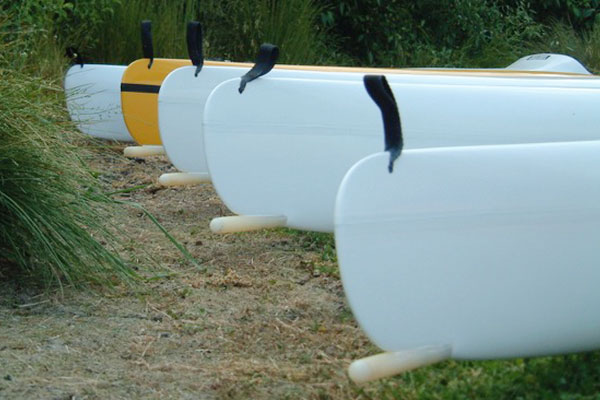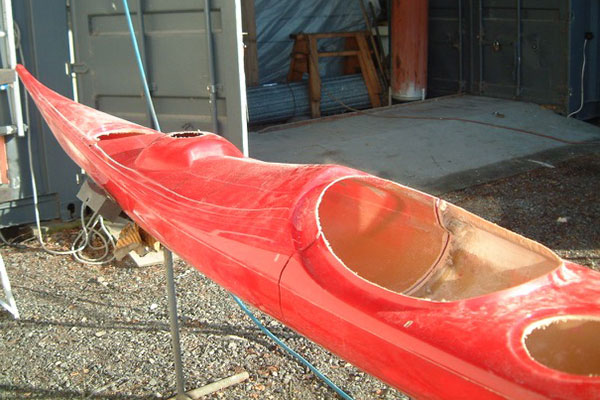How it all began!

TNL Export staff operating HPSD plant
Believe it or not – this business was formed in 1974 to manufacture specialised Perfusion High Pressure Sap Displacement (HPSD) brand equipment to preserve timber. This preservation machinery was by value 95% metal and 5% fibreglass. The original fibreglass ‘workshop’ started out as a very small workbench with a powered revolving mandrel in the centre. Our initial entry into fibreglass was very small in all ways – but very highly mechanised. These fibreglass timber preservation parts were subjected to test pressures up to 300psi. They had to be very strong.
In the spring of 1966 Grahame was introduced to river kayaking by Alan Eskrick, a Nelson Ski Club friend who had moved from Martin (true home of modern kayaking in NZ) with two folding PBK kayaks, of his own manufacture. What a terrifying and satisfying day we had on the snow-melt fuelled Wairau! I have the photos to prove it.

Hmmm. Alan yelled “don’t go there”. But too late I learned the channel ended in a manuka ‘strainer’
Following that trip, about twelve Nelson Ski Club members were energised to make their own PBK folding kayaks. These kayaks have many timber dowels that need resizing to fit the connecting tubes. My metal lathe was covered in wood shavings. Then I moved to Masterton and I took up hydroplane racing for five years. Repairing the hydroplane cowlings lead me to polyester fibreglassing skills.
Tradesmen painting my neighbours home in 1974 smelled the polyester resin used in the make the timber treatment equipment. They were “canoeists”. They followed the smell – and soon a modern fibreglass kayak ‘plug’ was made available to me.
This very first fibreglass Lettman Slipper kayak was made as a “hobby” in 1975. It was sold (by my workshop landlord) the same evening it was finished – before we had the opportunity to return to test it.

FOR HIRE trailer load of 20 Lettman Slipper kayaks. Wonderful marketing.
By 11am the next day we held nine forward orders for these German designed kayaks. Lettmen had gifted the design to the nation following the 1973 Commonwealth Games in Christchurch. This was in all ways the accidental business venture! I have yet to decide to become a kayak manufacturer.
Alongside the continuing metal work production the kayak and open canoe range was rapidly expanded.
By late 1976 we had developed the revolutionary compact Gap One kayak that later swept the world as Anne Dwyer’s Kiwi Kayaks Minnow.

Stephen Booth testing the Gap One. At the factory Stephen made Mitsubishi Ute tail lamp surrounds

Anne broadening the market to California Bird Watchers. Anne ran the Grand Canyon in a Gap One – to prove that it was a REAL kayak.
By 1977 we were building 7 kayak and open canoe models, including the Nordkapp under a royalty arrangement to VCP in the UK. By mortgaging the family home and importing the Nordkapp mould we started real sea kayaking, as a distinct sport, in New Zealand.

Hi tech 13kg Nordkapp used to circumnavigate Japan.
Kayak sales and exports boomed and the fibreglass business expanded into aircraft and motorbody parts. The timber preservation business still continued. Then one morning it all stopped. Muldoon had placed sales tax on boats (20% on wholesale), motorbody parts (33.3% on wholesale) and aircraft parts (50% on wholesale).
About the same time a horrible kayaking disaster occurred on the Aorere River in Golden Bay. Two of my customers died – and several of my staff were amongst the survivors. The river was in full flood and we all had a new understanding of the way a river current works. Ever since I have always recommended wider kayaks for beginners – because those who stayed in their kayaks that horrible day – survived.
The whole Sisson Industries Ltd business imploded totally by early 1980 – and we only-just survived by making tanks, hoppers and other farming related items. This agricultural business died instantly when farming subsidies were removed in 1984 – but that selective sales tax was replaced by GST on everything. Fairness at last. What to do – we employed a business consultant. Their report was to get back into manufacturing kayaks – and rename the business to reflect the description used by our customers to advertise their used kayaks. It came hard to drop the old Wildwater brand in favour of the new (yuk) Sisson Kayaks brand.
We branched into Down River Racing (DRR) kayaks and they sold by the trailer load to an outdoors store in Christchurch. The ‘secret’ market that they had found was the Lion Brown Coast to Coast race.
We went into sponsorship of events and athletes.

Here we see the Sisson Kayaks Racing Team – preparing to take out the Norsca Mountains to the Sea. We were noticed!
We kept making so many new kayak models. The best was the Delaware (The hull form came from my neighbours house painter) which was used by so many top achieving (good runner and cyclist) Coast to Coast place winners in 1986 and 1987.

The Delaware which rapidly sold 1000. Easy to make. Fast on the water. No other kayak established the SK brand faster. Great boat. The 1987 Speights Coast to Coast Top-Ten Men – Five paddled Delaware kayaks.
The Delaware was stable and fast. For my own use I started playing around with a rudder on my own DRR kayak. I loved the ability to use my big toe to correct my course – instead of mighty sweep-strokes.
In 1987 we invented the Multisport Kayak class with the introduction of the Triathlete model at the Norsca Mountains to the Sea race.

Grahame in Triathlete at 1987 Norsca Mountains to the Sea race. With cyclist Alan Fraine. Our Team runner Mal Clarbrough out of frame. I dislocated my shoulder but we still came 3rd Team.
This model had a Down River Racer hull and merged many features of a sea kayak. By making the Triathlete with a standard rudder we were the first New Zealand kayak manufacturer to commercially specify rudders to all river kayaks.

Grahame about 2009 with Triathlete – the worlds first multisport kayak. Zero ICF compliance & a rudder!
In 1989 we developed the worlds first double sea kayak with a centre cargo hold, allowing out-of-synch paddling, the Southern Light. We sold hundreds of these super safe kayaks to the rapidly developing kayak hire industry.
In early 1990 we introduced the Evolution Classic, the world’s first ‘long’ racing kayak. The ‘Evo’ -Classic would have to remain the most successful design in multisport. Keith Murray used a Classic to set his 1994 10 hours 34 minutes Speights Coast to Coast record – Keith’s record is still unbroken. Arguably the Evolution Classic is the fastest Multisport Racing Kayak – whilst Keith’s record remains unbeaten as at 2010.

Steve in the Evolution Classic
In 1992 we developed the Evolution Edge which is still in 2010 used by highly competitive athletes to win so many multisport races.

Steve Gurney in the Evolution Edge
For years Peter O’Sullivan has been running his race on the Rangeitiki River. He starts his race from the bank – enters his Evolution Edge – passes the field – and welcomes the eighty plus racers past his finish line.

Gordon Walker winning The Motu Race in his Evolution Edge
In 2009 we introduced the Evolution Omega – the first production racing kayak to be fitted with the ancient Inuit invention – the Bifurcated Bow. Gordon Walker and Dougal Alan proved that we have a better boat when they came 1st and second in the 2010 Speights Coast to Coast race.
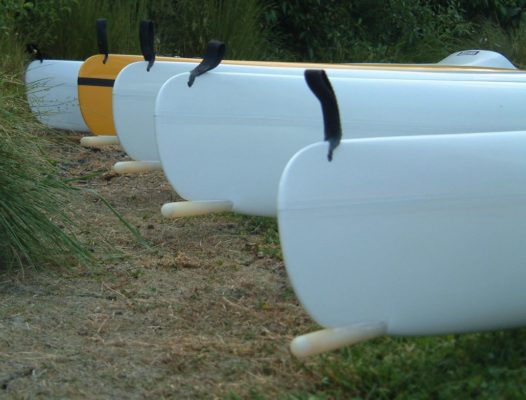
Evolution Omega complete with unpaid Inuit ‘Royalties’ – for stealing their bifurcated bow invention
Much of our sales revenue still comes from our classic range of sea kayaks – those classic proven designs just keep selling. In May 2007 Paul Caffyn took delivery of his latest (split in the middle too fly into Greenland) Nordkapp – exactly 30 years after taking delivery of his first South Island circumnavigation Nordkapp.

Paul Caffyn and Conrad Edwards in Greenland with split Nordkapps
The properties of wind and water do not change – so these kayaks all work as well as the day they were designed.

1998 world map showing coastlines paddled in Sisson Kayaks. Obsolete! Doubled by 2018.

Additions would include this split Voyager used to paddle the entire coastline of Turkey. The same kayak has done extensive trips in Asia.
And the fitout remains the same. It looks terrible in a shop – but sensible on a beach.
THE DEFINING MOMENT THAT WE WOULD NEVER WISH TO RE-VISIT
At 8.30am (staff at work) on the 19th June 1996 disaster struck in the form of a large factory fire.

19th June 1996 End of a dream
Our security monitor in Wellington knew of the smoke in the building 3 minutes before a 111 call was placed. Lynda and I were under a cloud of volcanic ash in Rotorua – heading to our next kayak demo in Tauraunga that evening. Our factory and moulds were all destroyed.

The demolition (dumping) cost $26,000
Everything except the demo boats. The rebuilding to our former 500-kayaks-per-year capacity was just too hard. The losses were too great. Our staff lost their quality ethic. They lost their jobs. We closed the business down – Grahame was heading into heart attack territory!
Thanks only to the encouragement from our good friend Matsumura, our Japanese agent, we reopened the business again, behind closed doors, to make, as a hobby, his previously ordered container-load of sea kayaks.

Our Japanese agent Matsumura, who encouraged the ‘re-opening’ of Sisson Kayaks after the fire.
This was the beginning of the one-man-band low-pressure-zone. This slower paced production turned out to be enjoyable, with more personal focus and zero stress. The kayaks were the best Matsumura ever received. And they were very satisfying to build.
For more Sisson Kayak history go to NEWS and click on PEAK KAYAK and MULDOON BOAT TAX

For many years a top seller
Finally (ripped from original SK website)
Caffyn’s Comment – with photos missing
Interesting facts about rudders – from someone who knows.
Paul Caffyn, RD 1, Runanga. West Coast.
email: kayakpc@xtra.co.nz
Rudders
To kick off my first ‘comment’ for the Sisson Kayaks website, I will describe the evolution of, and benefits of using, a deep draft overstern rudder. Initially I suffered from the Pommy anti-rudder sentiment but through a process of experimentation and the school of hard knocks, I developed a rudder system that I use 100% of the time.
During my very first sea kayak expedition around Fiordland in 1977/78, Max Reynolds and I used small retractable skegs that were attached to a ‘shoe’ or fibreglass sleeve that slid over a Nordkapp stern. Only the size of a cigarette packet, the skeg was rotated into position in deep water by the other paddler.
It evolved during the South Island trip into a deep shark fin shaped skeg, mounted on a ‘sleeve’ that sat loosely on the stern for launching and was pulled into position with a cord from the cockpit. Shock cord, from the stern to the skeg, allowed the skeg to ‘retract’ out of the way for landing. For following, or quartering seas from the stern, the skeg improved the kayak’s tracking in a straight line.
For the start of the Australian trip I used a HM Nordkapp, with the extended keel stern, but after a gripping experience of being unable to turn up-wind on a flat sea in gale force winds, I cut the extended bit off and reverted to using my shark fin skeg.
The Dreamtime Voyage, Around Australia Kayak Odyssey by Paul Caffyn
“The Dreamtime Voyage”
Around Australia Kayak Odyssey
Cresting the Restless Waves, North Island Kayak Odyssey by Paul Caffyn
“Cresting the Restless Waves”
North Island Kayak Odyssey
Prior to the trip I was intrigued by the deep draught, overstern fibreglass rudders that the Tasmanian paddlers considered, not as optional extras but as integral parts of their boats. Photographs of the seas they paddled and accounts of long distances achieved with rudders in diabolical conditions, led me to thinking about trialing a rudder.
When I broke the skeg blade off south of Brisbane, a friend helped me build a sturdy Tasmanian style rudder out of aluminium. Still with a mind set about kayaks and rudders, we mounted the rudder on a fibreglass ‘shoe’ or sleeve, that slid over the Nordkapp stern, and was held in place by the decklines. Well, the mind set disappeared with the first long surfing run north of Brisbane, and the rudder stayed in place for the rest of the trip.
It saved my life on several occasions, the most crucial being the overnighter along the Baxter Cliffs.
The statistics show the benefit gained:
Melbourne to Sydney HM stern 30.6 miles per day
Sydney to Brisbane Skeg 34.3 miles per day
Brisbane to Cape York Rudder 39.2 miles per day
Contrary to notion of a rudder being, ‘not for steering, but to trim. Sea kayaks are steered with the paddle, like all kayaks and canoes,’ I use my rudder for steering and the paddle for forward propulsion.
When a paddle is used for corrective steering strokes, either sweep or paddling on one side, forward propulsion suffers and the normal paddling cycle is upset.
Naturally the design, structure and mounting determine the difference between inefficient and efficient rudders. Some rudders flop around in their mounts like jelly on springs. My rudder blade project 12” below the keel line. I have never broken a rudder – bent the blade once off North Queensland in a big surf, but straightened it out over my knee on shore and it was good for another 6,000 miles.
Dark Side of the Wave, Stewart Island Kayak Odyssey by Paul Caffyn
“Dark Side of the Wave”
Stewart Island Kayak Odyssey
Iceberg
click photo to enlarge
Situations where I have found a rudder to be invaluable include:
Paul Caffyn sea kayaking
tight manoeuvring in congested sea ice or ice berg choked seas
Paul Caffyn sea kayaking ferry gliding across channels with fast tidal streams
Paul Caffyn sea kayaking coping with boils and eddies in overfalls
Paul Caffyn sea kayaking steering when the wind is too strong to paddle
Paul Caffyn sea kayaking fast manoeuvring in congested shipping lanes
Paul Caffyn sea kayaking hugging a reef fringed coast when paddling into a strong tidal stream flow
Paul Caffyn sea kayaking surfing in front of following seas
Another advantage of a sturdy deep draught, overstern rudder is a surprising increase in overall boat stability.
The most magic sound I hear at sea is a humming vibration generated during fast surfing runs at up to 15 knots, either when surfing boat wakes or in front of following seas.
Sheer magic!
Books
If in need of inspirational bedtime reading for scheming outrageous paddling adventures, drop a line or email me for a book cattledog of new and secondhand sea kayaking titles, including the Round Aussie, Stewart & North Island titles.
Huskies
No, these aren’t cattledogs
click photo to enlarge
P. Caffyn, RD 1, Runanga. West Coast.
email: kayakpc@xtra.co.nz
